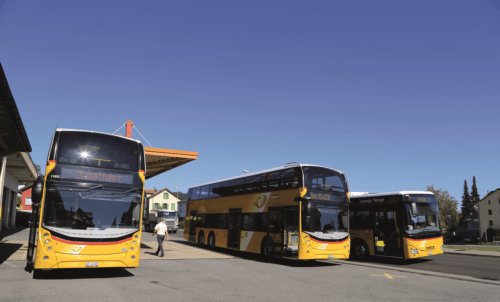
Jonathan Welch takes an Enviro500 for a drive in the Swiss Alps, and considers the model’s international appeal
Alexander Dennis’ Enviro500 has been around for a while now, although it may still be unfamiliar to many in the UK. It’s tempting to call the Enviro500 a ‘model’ the same as its smaller Enviro400 or Enviro200 stablemates, but in reality, the type encompasses a whole range of models designed to serve the different niches and needs on multiple continents. First unveiled in 2002 under the Transbus banner, the type has seen use in North and South America, Asia, New Zealand and Europe, as well as one-offs and trials elsewhere.
Within the British Isles, a few early examples were sold. First ordered a batch for services in Glasgow which required a vehicle with a higher capacity than a standard double-decker, and Dublin Bus took a total of 70 from 2005 to 2007 based on the Volvo B9TL chassis. The former are still with First, having replaced articulated buses on Aberdeen’s busy trunk routes 1 and 2, though recent transfers have seen a number head south to First Kernow. Of the Dublin Bus examples, some made their way to the UK for a second life after withdrawal in 2018, including with D&E Coaches in Inverness. More recently, Lothian has taken delivery of a number of tri-axle double-deckers which appear very similar to the latest Enviro500s, but which are based on Volvo underpinnings and badged as Enviro400XLBs.
A recent headline order for Alexander Dennis has been the purchase of 200 of the type for Berlin city operator BVG to replace MAN double-deckers on busy cross-city routes. Another place where the type can be found in Europe is Switzerland, where iconic yellow operator PostBus, or PostAuto in Swiss German, has a fleet of them for commuter services, as does fellow Swiss operator TL in Lausanne.
Heiden
A trip to Switzerland earlier this year gave me the chance to have a closer look at one of the PostBus examples at its Heiden depot. The small town of Heiden, with a population in the mid-4,000s, lies in the hills above Lake Constance some 1,300 feet below, and is linked to it by a rack railway. For PostBus’ Enviro500s, though, the key destination is further west, and the city of St Gallen, with many people commuting from the surrounding region each day.
[…]By subscribing you will benefit from:
- Operator & Supplier Profiles
- Face-to-Face Interviews
- Lastest News
- Test Drives and Reviews
- Legal Updates
- Route Focus
- Industry Insider Opinions
- Passenger Perspective
- Vehicle Launches
- and much more!


